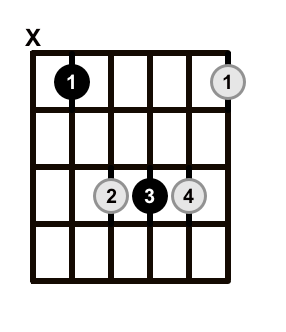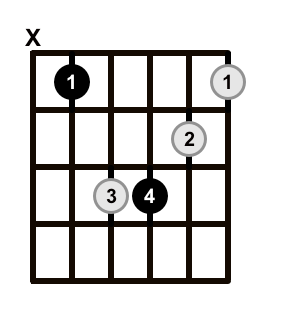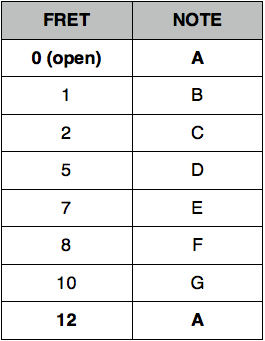In today’s lesson, we’re going to jump right into bar chords (also written as barre chords). If guitar chords could be placed neatly into two boxes, one would be called open chords, the other would be called bar chords.
You’ve learnt 15 open chords and you know that with them, you have the ability to play thousands of songs. There are certain chords though, that can’t be played as open chords. For this, we need bar chords.
What Are Bar Chords?
Before we explain exactly what bar chords are, and their uses, it’s worth talking a bit more about open chords. Open chords, by definition, are chords that have open strings in them. There are technically hundreds of open chords (because any possible shape that you form that includes an open string is technically an open chord), but there are a bunch that we use most of the time.
In the lesson on intervals and the fretboard, we learnt that we can move a note up a semitone by moving it up a fret. We can do that with chords too. Technically, if we move every note of a D Major chord up one tone (2 frets), it becomes an E Major chord. Easy, right?
Why Can’t You Move Open Chords?
The problem with applying this theory to open chords, is that by moving the shape of an open chord up (or down) the fretboard, only the notes that are being fingered move, while the open notes stay the same. Remember, when we play an open string, we are technically playing a ‘0’. If we simply shift an open chord shape up one fret, the zeros stay as zeros, while the other numbers move. This effectively changes the structure of the chord and usually results in something that sounds weird.
Bar Chords Are Moveable
The point of this little analysis of open chords is that it highlights one of the benefits of bar chords. Bar chords, by definition include a finger that is ‘barring’ most of the strings. There are no open notes with standard bar chords. What this means is that when we learn a bar chord shape, we can play it anywhere along the fretboard. They are said to be ‘moveable’, in the same way that scale shapes are moveable.
How To Play A Bar Chord
We’ll talk more about using bar chords shortly. What we are going to do now is look at a bar chord shape and discuss how to play it. The following is a ‘Major chord’, played as a bar chord:
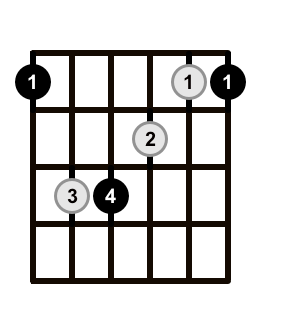
As you can see from the diagram, the 1st finger is playing multiple strings. This is achieved by literally ‘barring’ your finger, so that it straightens out and can cover multiple strings.
Have a go at playing the chord. Remember, it is a moveable chord, so you can try playing it anywhere. I recommend starting around the 5th fret, where the frets aren’t too wide and aren’t too narrow either. Playing the bar chord on the 5th fret would result in an A major chord being played (we’ll discuss how to figure this out soon). From a notes/tabs perspective, it would look like this:
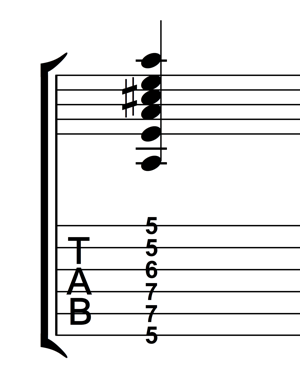
Don’t Be Too Fussy
Unless you are just naturally gifted with strength and technique, you will probably find that it feels weird and sounds pretty bad. This is normal. Most people struggle to get a clear sound with bar chords when they first attempt to play them. Being able to play bar chords cleanly and effectively requires a steady build up of strength and technique, which of course, only comes about with consistent and steady practice over time.
A Closer Look At The Bar
It’s worth having a closer look at the finger that performs the ‘barre’. Have a look at the following chord diagram, which shows just the first finger performing the bar, on the 5th fret:
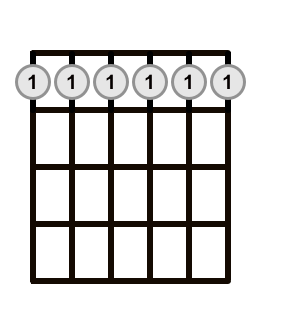
This image shows what the 1st finger is doing when playing the bar chord that we looked at. This is worth looking at for a few reasons.
Firstly, you can see what the 1st finger should look like. It is straight, with even pressure being applied along the length of the finger. This is what the 1st finger should be doing. The other fingers come in and effectively play over the top of this bar, but the bar shouldn’t change.
Secondly, playing just the bar by itself is a good strength exercise. It’s good to practise because it allows you to focus on the most difficult part of the bar chord (the bar). It is a good idea to form the bar by itself and then play each string individually, to see if you can get each note to ring out cleanly. It’s hard, but it’s a great exercise in building strength. You will most likely feel your hands and fingers fatiguing pretty quickly when practising in this way.
Introducing The Minor Chord
Before we start putting the bar chord that we have just learnt to good use, let’s look at another shape. The following shape is for the minor chord, played as a bar chord.
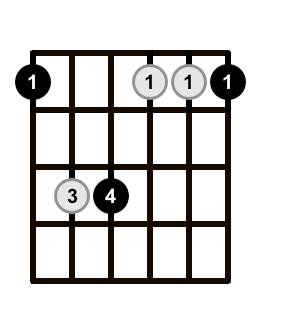
As you can see, the minor chord is very similar to the Major chord. In fact, to play the minor chord all you have to do is play the major chord shape and then take your 2nd finger off. An ‘A minor’ chord (minor bar chord shape played on the 5th fret) would sound like this:
Just like with the Major chord shape that we did, practise playing the minor chord, and don’t get disheartened if it doesn’t sound perfect in the beginning.
Why Bar Chords Are So Useful
The main benefit of bar chords is that they are moveable. What this means is that by learning one shape, you are effectively learning twelve chords. By playing the the Major chord shape starting on the 5th fret, you are playing an A Major chord. By playing the major chord starting on the 10th fret, you are playing a D major chord. The same applies to the minor chord. So how do you know which chord is which? By being familiar with the 6th string. With each of the two bar chords that we looked at, the root note is played on the 6th string. In fact, it is also played on the 4th string (up an octave) and on the 1st string (up another octave), but the 6th string is a better reference point. Have a look at the chords again. The root notes are darker.


Because the root note is played on the 6th string, we just need to know the notes along the 6th string to determine which chord we are playing.
Of course, you already know how to figure that out, using what you learnt in the lesson on intervals, but for the sake of this lesson, here is a chart displaying the notes along the 6th string:
The sharps and flats aren’t written, but they are obviously the ones in between. If you’re not too sure how sharps and flats work, read this lesson.
So for example, if you wanted to play a G Major chord, you would play the major shape, starting on the 3rd fret (because the 3rd fret of the 6th string is G).
If you wanted to play a C minor chord, you would play the minor shape, starting on the 8th fret of the 6th string (because the 8th fret of the 6th string is C).
It means that to use bar chords effectively, you need to be familiar with the notes along the 6th string. We already discussed the importance of knowing the fretboard, and it’s obviously extra important for bar chords. The good news is, playing songs that use bar chords is a great way of learning the notes along the 6th string. There are only so many times that you can play a D Major bar chord before you remember where D is. Just get playing!
How To Use Bar Chords
Introducing bar chords into your playing can be tough at first. Like I said, bar chords don’t sound that great to start with. This presents a bit of a catch-22 situation; people avoid practising them because they don’t sound good initially. Because they’re not practising them, they never improve. You get the picture. You have to avoid this trap. The sooner you start practising bar chords, the sooner you will get over that initial, painful stage and get to the point where you can use bar chords as easily and enjoyably as open chords.
Here is a good process to follow for integrating bar chords into your playing. The time spent in each phase will vary for each individual, so be patient and enjoy the process:
Start Out Just Playing The Shapes
This might seem obvious, but the first step is to memorise the shapes, and then practise playing them. The important thing with this stage is that you don’t need to use them in a musical context. Don’t get out the song book just yet. All you need to do is play the shapes, observe how they sound, and where the weaknesses may be. You will naturally improve your strength and technique by doing this. If you set yourself the goal of using them seamlessly in a song before you have had a chance to simply ‘hang out’ with the chords, you will get discouraged.
Move From One Chord To Another
The next step is to practise moving between two bar chords. Start off with just two bar chords and practise going from one to another. Here are a few examples. In each of the following exercises, whole notes are being used. This gives you more time in between chord changes and allows you to not worry about strumming (just yet).
Bar Chord Exercise 1

Bar Chord Exercise 2

That is only two exercises, but of course you can make your own combinations.
Use Bar Chords And Open Chords Together
Once you feel like you have made progress with moving from one bar chord to another, you should start using bar chords in combination with open chords. Using bar chords with open chords allows you to effectively ‘ease’ bar chords into your playing, while using open chords that you are hopefully already comfortable with.
It’s important to remember that there is no functional difference between a chord that is played as an open chord and one that is played as a bar chord. That is to say that there is not much difference between a G major chord (for example) played as an open chord and a G major chord played as a bar chord. Both versions have a slightly different sound, but for all intents and purposes, they are the exact same chord.
What this means is that you can take a chord progression that you can already play using open chords and substitute one of the chords with a bar chord. Because only one of the chords will be played as a bar chord, it should make the task of playing the bar chord a bit easier. You can effectively relax through the open chords and apply extra focus when you get to the bar chord.
Here is an example of a chord progression being played using open chords.

Now try playing the same chord progression still using open chords, but use a bar chord for the G major chord. Both versions, played correctly should sound very similar. Listen to the version with the G major chord played as a bar chord:
Play Songs And Exercises Using Only Bar Chords
The ultimate test of bar chord prowess is to be able to play entire chord progressions using only bar chords. Being able to do so means that you are comfortable with the bar chord shapes, can move comfortably from one to another and have a sound knowledge of the 6th string (so that you know which chord you are playing). Let’s have a look at another chord progression. Try to play this exercise using only bar chords.
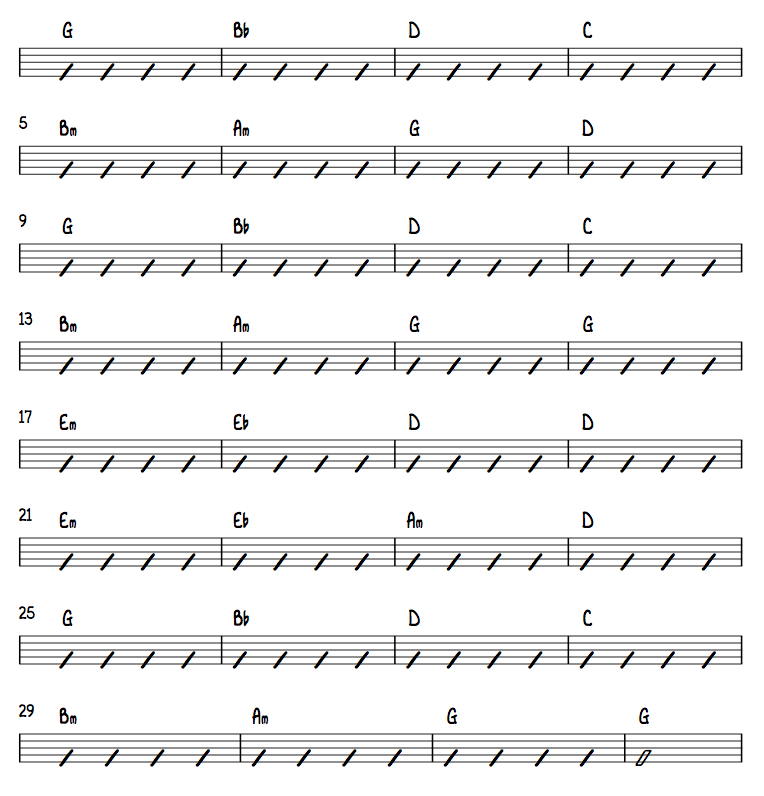
Introducing Root-5 Bar Chords
The bar chords that we have looked at up until this point come under the category of ‘root-6 bar chords’. This basically means that the root note for the two shapes that we looked at, falls on the 6th string. As you may have guessed, there are other bar chords as well. We are now going to look at ‘root-5 bar chords’.
We are going to look at two more shapes. The chord types are exactly the same as the two root-6 shapes that we learnt – Major and Minor. The difference is that for the following two shapes, the root note is found on the 5th string. Let’s have a look at the two shapes:
As you may have guessed, if we want to put our root-5 bar chords to good use, we need to be familiar with the notes along the 5th string. Here is a chart that tells us where the notes are along the 5th string:
Root 6 and Root 5 Bar Chords Together
With a root-6 bar chord, playing G major requires you to play the major shape on the 3rd fret, because that’s where G is on the 6th string. As you can see from the above chart, if we want to play a G major using the root-5 bar chord shape, we need to go to the 10th fret, because that’s where G is on the 5th string.
This means that we now have even more options. Some chords can be played as an open chord, a root-6 bar chord and a root-5 bar chord.
So how do you know which one to use? There is no real definitive answer. Often it just depends on the context. Often it doesn’t really matter. While it can seem daunting to have options (especially if you’re still trying to deal with one set of chords), having options can often make things easier. Let’s look at the following chord progression as an example:

Let’s assume that we are going to play the four chords using bar chords.
If we only used root-6 chords, we would get the following:
- A Major (5th fret) – D Major (10th Fret) – B Major (7th Fret) – E Major (12th Fret)
As you can see, using only root-6 chords requires us to jump around a fair bit. This might be the effect that you are after, but it seems like too much work.
Let’s now look at where we would need to play the chords if we only used root-5 bar chords:
- A Major (12th fret) – D Major (5th Fret) – B Major (2nd Fret) – E Major (7th Fret)
As you can see, there is even more jumping around now. Not great.
When we use a combination of root-6 and root-5 bar chords, we are able to arrange things so that we don’t have to move around as much. This makes things easier, but it can also make things sound more organised and flowing. Let’s look at the following combination example:
- A Major (5 fret, root 6) – D Major (5th Fret, root 5) – B Major (7th Fret, root 6) – E Major (7th Fret, root 5)
As you can see, we barely have to move when using the right combinations.
How To Introduce Root 5 Chords
It’s a good idea to not worry about playing root-5 bar chords until you start becoming comfortable with root-6 chords. You will find that root-5 chords aren’t that hard if you can already play root-6 chords, because after all, you will effectively just be learning a few more bar chords. You will not be learning a new technique like you are when you play bar chords for the first time.
When it’s time to focus on root-5 bar chords, it’s a good idea to play a few songs and exercises using only root-5 bar chords, just so you become familiar with the shapes and positions. Once you are comfortable with them, use them in combination with root-6 chords and open chords.
Give It Time
The purpose of this lesson is to introduce you to bar chords by showing you how to play them, how they are used, and giving you some approaches to practising. Of course, mastering them can take many weeks (or months), so you should not rush things. This lesson is similar in approach to the lesson on reading notation – there is more in this one lesson than you can probably master in one sitting, but the concepts are relatively straight forward.
What this means is that you should read the whole lesson, take in and understand all the information and principles, but give yourself time to develop your bar chord playing.
Perhaps you are still trying to master open chords. That’s fine. You now have an understanding of bar chords and will be more prepared when it comes time to getting stuck into bar chords. Just like any of the lessons in this series, feel free to come back to this lesson as often as you need.


